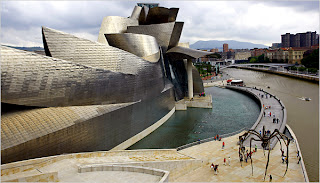When
architects and urbanists speak about Bilbao effect they mean a phenomenon of
regeneration and revival of depressive territory after building there some
extraordinary architectural performance. Let’s find out how Spanish city of
Bilbao recovered its lost reputation and became a mecca for industrial and
creative classes. What is the main reason of regeneration: stupendous ideas and
people’s wishes or just fabulous money?
Today it’s difficult to determine the foundation date of Bilbao. There are references going to III or II century A.D., but most of historians incline to XI-XII century when small fisherman’s hamlet got a town status. Gradually Bilbao developed and became one of the biggest Spanish sea ports, by the XIX century after iron ore deposit displaying and after industrial revolution the city became large commercial centre in Spain, in the XX century it was the best-off city there, banks and insurance companies founded in this city. Runaway industry attracted a lot of immigrants and Bilbao population increased actively.
 The
situation cardinally changed after 1997 when American architect Frank Gehry
built in Bilbao a department of famous Guggenheim Museum, significant place of
modern art. Architect would not be satisfied by usual restoration of spaces and
offered his own project, too unimaginable. Result surprised any skeptics:
technically perfect building has fluent lines, plastic unusual forms, light’s
plays. $75,000,000 is the cost of Guggenheim Museum, where and how Basques got
that unbelievable money is a great answer.
The
situation cardinally changed after 1997 when American architect Frank Gehry
built in Bilbao a department of famous Guggenheim Museum, significant place of
modern art. Architect would not be satisfied by usual restoration of spaces and
offered his own project, too unimaginable. Result surprised any skeptics:
technically perfect building has fluent lines, plastic unusual forms, light’s
plays. $75,000,000 is the cost of Guggenheim Museum, where and how Basques got
that unbelievable money is a great answer.
A lot of significant architects had a hand in Bilbao development and buildings. Santiago Calatrava built a white bridge “Subisuri”, Norman Foster built subway which today has two lines. Airport terminal, eco-tram lines, a lot of pedestrian zones, new flyovers, parks, also appeared there. Transport infrastructure was improved, river Nervion was cleaned, territories suffered from the flood were restored.
Today it’s difficult to determine the foundation date of Bilbao. There are references going to III or II century A.D., but most of historians incline to XI-XII century when small fisherman’s hamlet got a town status. Gradually Bilbao developed and became one of the biggest Spanish sea ports, by the XIX century after iron ore deposit displaying and after industrial revolution the city became large commercial centre in Spain, in the XX century it was the best-off city there, banks and insurance companies founded in this city. Runaway industry attracted a lot of immigrants and Bilbao population increased actively.
But in 70s Bilbao’s
golden years finished, world commercial ways changed, 20% of population were
unemployed, and in addition a great flood in 1983 destroyed an important part
of territory, thousands people died. Heavy economic crisis began there, Bilbao
was really a god-forsaken hole.
 The
situation cardinally changed after 1997 when American architect Frank Gehry
built in Bilbao a department of famous Guggenheim Museum, significant place of
modern art. Architect would not be satisfied by usual restoration of spaces and
offered his own project, too unimaginable. Result surprised any skeptics:
technically perfect building has fluent lines, plastic unusual forms, light’s
plays. $75,000,000 is the cost of Guggenheim Museum, where and how Basques got
that unbelievable money is a great answer.
The
situation cardinally changed after 1997 when American architect Frank Gehry
built in Bilbao a department of famous Guggenheim Museum, significant place of
modern art. Architect would not be satisfied by usual restoration of spaces and
offered his own project, too unimaginable. Result surprised any skeptics:
technically perfect building has fluent lines, plastic unusual forms, light’s
plays. $75,000,000 is the cost of Guggenheim Museum, where and how Basques got
that unbelievable money is a great answer.A lot of significant architects had a hand in Bilbao development and buildings. Santiago Calatrava built a white bridge “Subisuri”, Norman Foster built subway which today has two lines. Airport terminal, eco-tram lines, a lot of pedestrian zones, new flyovers, parks, also appeared there. Transport infrastructure was improved, river Nervion was cleaned, territories suffered from the flood were restored.
The reason
of such high costs is Basque regionalism or separatism, the system when a lot
of taxes don’t go to Madrid but keep on the territory and expend for local
development. Four millions tourists visited Bilbao during three years after
Guggenheim Museum opening, tourism gave $89,000,000, and in tote during four
years Bilbao’s budget got $455,000,000.
Often
endeavors to reiterate Bilbao’s experience are unsuccessful. It’s necessary to
find approach to city and its residents, take into account its individuality,
economic features and at the end history of territory. Great architectural
creations are like excuses of incredible investments but without above-listed
factors it will be impossible to cover costs.
By Valentin
Ivanov
For more
information please visit ID-reel.com



No comments:
Post a Comment